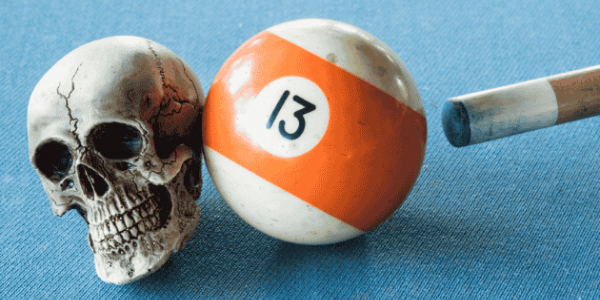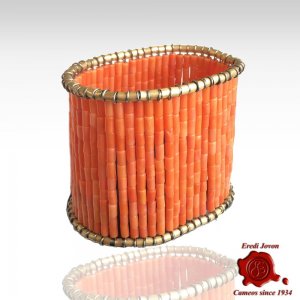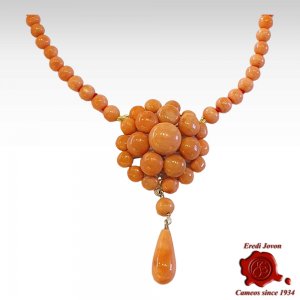Sciacca coral: Antique Sicilian red (orange) gold

What is the ancient coral of Sciacca?
Today we talk about: Antique Coral Jewelry
Sciacca’s gold (as it is customary to call it) is perhaps the most mysterious antique coral that exists in nature: it is often very small in size and its color varies from dark orange to yellow with sometimes black streaks.
Those who follow our blog for some time know how we are: we like to go straight to the point.
Let’s answer the question immediately: Sciacca coral is part of the "corallium rubrum" family.
How was and is (rarely) still used this precious material in jewelry?
Earrings, rings and necklaces in Sciacca Antique Coral are ancient jewels of a unique orange (but not only orange, as I said earlier) and of a refined manufacture, which is now unobtainable: very few artisans are able to make jewelry that respects that kind of quality and the ancient tradition.
Being part of the Mediterranean red family the clumps of this coral are not large and, about a century ago, they were used mainly to create little balls, buttons, cops and "cannette" (a typical cut in the shape of a very narrow tube).
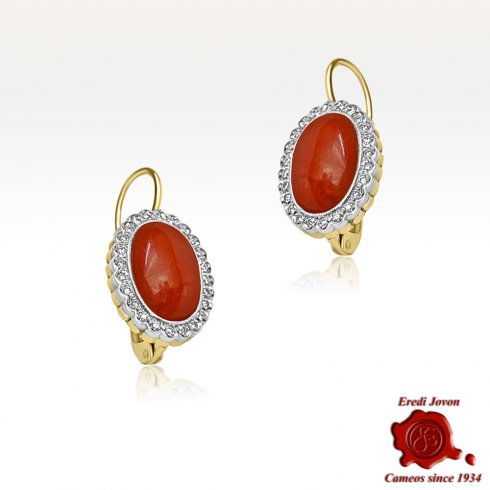
Red Italian Coral Jewelry
Red Italian Coral jewelry in 18 kt Gold and diamonds - Certificate Included on Every Piece
Red Coral JewelryThe jewels: use of the famous "Sciacca’s gold"
This is how Sciacca large antique coral earrings are often created, using dots and buttons put together and supported by a sort of gold basket, created by master jewelers.
Sciacca's antique coral necklaces are thus embellished with central pieces, created in the same way and often enriched with particular pieces engraved in the shape of fruit, leaf or flower: the mastery of the goldsmiths, in creating the basket, and the skill of the engravers, in creating the individual pieces engraved or smooth, therefore, makes each model unique and unrepeatable.
A ring or an antique coral earring from Sciacca is, therefore, a much sought-after jewel: only the oldest and most renowned companies can, therefore, create jewelry with "Sicilian gold".
But let's try to understand why and return to your other possible questions ... maybe the more technical ones.
Sciacca coral is therefore Mediterranean coral in all respects: so it is simply not red?
Its name is often abused by jewelers all over the world and it navigates in the safe and presumptuous waters of hearsay, creating, as in the whole coral world, even more confusion (if ever there was still need of it
Do not be fooled by the fact that it is different in color. It is true, however, that it is a particular "corallium rubrum" coral in color and that this remains, of course, the most obvious aspect, but it is not only the difference.
Without going deep into the merits of a heated scientific discussion, which still seeks the origins of this precious material, I will tell you that "Sciacca's gold" is a sub-fossil coral, dating thousands (millions?) of years ago, which stratified into three deposits discovered at the end of the 19th century. Even today it is difficult to understand how an organic material such as coral, subject to decomposition, could have reached us intact and beautiful in its so particular shades of orange. The definitive answer according to the experts is now very close: I invite you to read Dr. Rajola's book.
Instead, let’s investigate its peculiarities: the reasons why this coral is considered unique and rare.
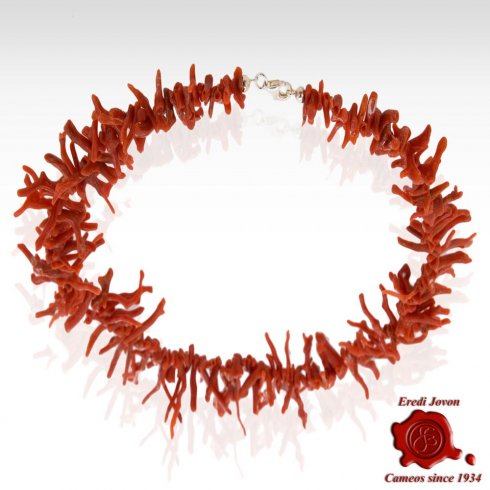
Red Italian Coral Jewelry
Red Italian Coraljewelry in 18 kt Gold or in White Silver 925% - Certificate Included
Red Coral JewelryWhere and when did this "miracle of nature" happen?
where:
Let's start with where: only in the Sicilian Channel, about 30 miles from the port of Sciacca, and probably due to the intense underwater volcanic activities of this stretch of sea, this coral has assumed such unique shapes and colors. At the bottom of the sea there is, in fact, a submerged volcano and seismic activities have been reported for hundreds of years: I invite you to discover the history of the island Ferdinandea, "the island that is not there".
So the “where” is essential: only in this area these exceptional conditions were created!
When:
Between 1875 and 1900, three deposits, coral reefs, were discovered almost by chance, one by one more generous than the other: the peculiar feature of the reefs was the fact that each one provided tons of raw coral. In practice each field gave an unusual amount of coral.
And if the answer was: because we were faced with coral that had settled over millennia? This makes us think that the theory of coral deposited in millennia is the most valid.
But what happened after the discovery of so much coral?
At that point there was a coral invasion in the market that led some companies to bankruptcy (too much supply in the face of the demand): on the contrary, families with greater or farsighted economic potentials thought well to put aside the antique coral and today they hold a small treasure of it.
Getting back to today, every crisis corresponds to an opportunity.

Red Coral Beads Necklace Chain from Italy
Italian Red Coral Beads Necklace, genuine (with certificate) first choice mediterranean coral chain traditionally 18 inches long.
Red Coral Beads NecklaceIs Sciacca coral still found today?
Today: Some companies still own raw Sciacca coral, treated as a relic, and legend has it that some have found small treasures from their grandparents hidden inside the houses.
The answer is therefore: yes, there are still rough coppers of Sciacca in old laboratories and old companies and, exceptionally, it is still worked by a few skilled hands.
In our laboratory we still repair ancient coral jewelry and we are proud to bring back old masterpieces, often using techniques that were in vogue more than 100 years ago. The satisfaction we feel in giving the right product or the right answer to our customers is the most beautiful thing that our work gives us.
I invite you to download our book on Italian red coral: it is freeand it brings a little bit of clarity on this material so beautiful, but unfortunately still unknown to most people.
The biggest hug in the world

Hope you liked this Post, you can get even more info about:
Information
Last post
-

Love Hope Faith Amulet | Meaning and Tradition
Discover the meaning of the Faith, Hope & Charity charm: a timeless amulet to wear every day. A jewel that tells...
-
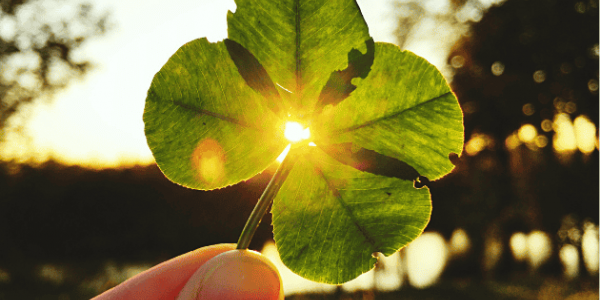
The Four-Leaf Clover: the rare gift that dares to speak to the heart
Discover the true meaning of the four-leaf clover and its Italian twist with the lucky cornetto charm—a rare story...
-
